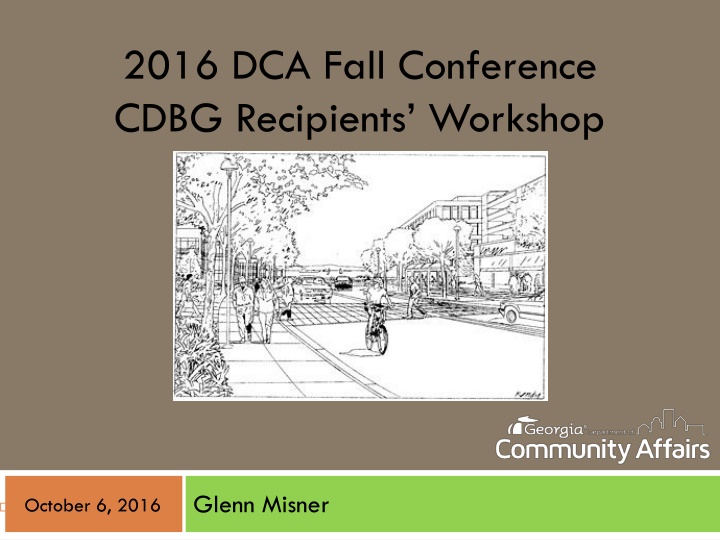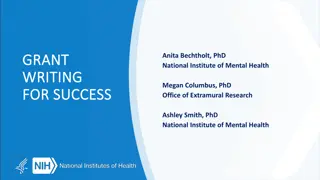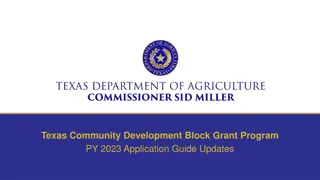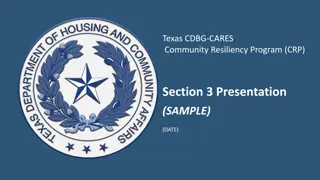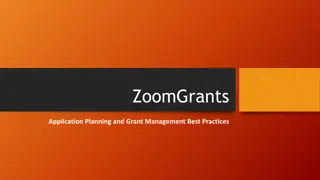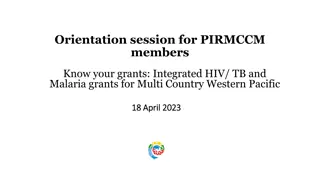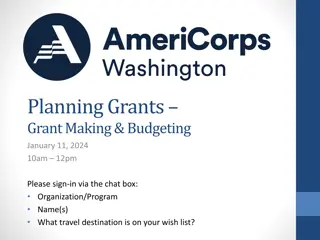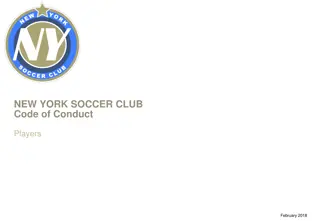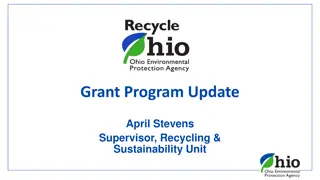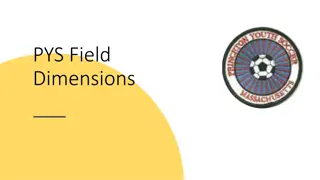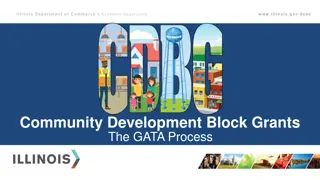Key Players and Requirements in Managing a Grant Program
This content covers essential information for managing a grant program, including key roles such as Program Director, Rehabilitation Advisor, Appraiser, and General Contractor. It also delves into topics like minimum property standards, building codes, and the necessary skills and responsibilities each role should possess. Understanding these roles and standards is crucial for successful grant management and execution.
Download Presentation

Please find below an Image/Link to download the presentation.
The content on the website is provided AS IS for your information and personal use only. It may not be sold, licensed, or shared on other websites without obtaining consent from the author.If you encounter any issues during the download, it is possible that the publisher has removed the file from their server.
You are allowed to download the files provided on this website for personal or commercial use, subject to the condition that they are used lawfully. All files are the property of their respective owners.
The content on the website is provided AS IS for your information and personal use only. It may not be sold, licensed, or shared on other websites without obtaining consent from the author.
E N D
Presentation Transcript
2016 DCA Fall Conference CDBG Recipients Workshop Glenn Misner October 6, 2016
Congratulations, You ve won a Grant Now What? Topics we ll discuss today: Key Players and their roles Minimum Property Standards and Building Codes Housing Inspections Work Write-ups, Cost Estimates, Scope of Work Bidding Procedures Elements of a Construction Contract Oversight of the work
The Players and their roles The Program Director Develop and administer the program Supervise a competent and efficient staff Effectively communicate with elected officials, program participants, and contractors Address local groups and gatherings Ensure all reports, documents, and paperwork are submitted on time May or may not be an employee of the local governing body
The Players and their roles The Rehabilitation Advisor Construction and construction costing experience is a MUST Proficient in inspection procedures Ability to develop clear and coherent work write-ups, specifications, and cost estimates Knowledgeable of Lead Based Paint regulations Communicate with all levels of the community especially homeowners and contractors
The Players and their roles The Appraiser The appraiser is not usually a fulltime employee but rather a competent resource. He/she should be well experienced and well respected in the local community. He/she should be certified by the Ga. Real Estate Appraisers Board.
The Players and their roles The General Contractor This person can help your program receive national recognition or put you in jail. They can be the best or the worst part of your program! He/she should be a respected member of the community with a good reputation Construction experience and especially with rehab projects is essential Due diligence is essential MORE ON CONTRACTORS LATER.
Minimum Property Standards and Building Codes Georgia Building Codes The State of Georgia currently follows the International Residential Code for One and Two Family Dwellings, 2012 edition with Georgia Amendments One of several State Mandatory codes shall apply to the construction, alteration, movement, enlargement, replacement, repair, equipment, use and occupancy, location, removal and demolition of detached one- and two-family dwellings
Minimum Property Standards and Building Codes Georgia Building Codes Optional Permissive code: International Existing Building Code 2012 Edition with Georgia Amendments
Minimum Property Standards and Building Codes Georgia Building Codes International Codes resource: www.codes.iccsafe.org Georgia Amendments: dca.ga.gov
Minimum Property Standards and Building Codes Minimum Property Standards (MPS) Defined: A set of standards, created or adopted by the local governing body, that sets forth minimal conditions specific to property, structures, or environs within the community and describe what is decent, safe, and sanitary
Minimum Property Standards and Building Codes Minimum Property Standards may also: function as a base line of materials used, material properties, structural design, etc. may exceed Georgia building codes but may not hold a lower standard
Minimum Property Standards and Building Codes Minimum Property Standards may define: What materials may and/or may not be used The properties of the material (e.g. grade of lumber, PSI rating of concrete, durability of roof shingles, etc.) How the materials will be installed, used, or applied May be associated with certain zoning regulations
Minimum Property Standards and Building Codes Minimum Property Standards Sample MPS may be obtained from a variety of sources including some off-the-shelf software programs You may develop you own MPS, however, make sure that they do not compromise other related standards or Georgia codes
Housing Inspections Preliminary work Have a working knowledge of Ga. Building Codes and local MPS Prepare a tool box of tools you ll likely need: flashlight, good screwdriver set, pliers, pocket knife, probing tools, measuring tape, and writing pad/electronic device Ensure adequate access to ALL areas of the unit owner prep for inspection is critical! Do a walk around to get the feeling of the structure Take photographs of all four exterior elevations
Housing Inspections Preliminary work (continued) Take lots of photographs of interior rooms with notations Depending upon extent of work required, a floor plan is a good idea. Take accurate interior and exterior measurements If you have the capability, do a CAD drawing of the structure, or do a good quality scaled pencil drawing
Housing Inspections Preliminary work (continued) Make copious notes, memory joggers, dimensions, and material attributes (e.g. color. material, texture, etc.). You ll need them later guaranteed! Treat the owner with utmost respect. Respect the furnishings and d cor Don t touch anything you don t intend to inspect
Housing Inspections Lead Based Paint (LPB) Lead Hazard Evaluation is REQUIRED for Housing units built before 1978 Evaluation must be performed by a Georgia EPD Certified Lead Inspector and/or Risk Assessor Inspection verifies presence of LBP Risk Assessment identifies LBP hazards All lead hazards must be remediated Contractor must be Georgia RRP certified for lead work Once work is complete, the unit must pass Clearance Usually performed by the initial Lead Inspector/Risk Assessor
Housing Inspections Lead Based Paint (LPB) Required Notices to Owner/Occupants Signed Receipt must be in file o o
Housing Inspections Lead Based Paint (LPB) Required Disclosures to Owner/Occupants LBP Pamphlet given within 60 days of starting work Copy of Inspection/Risk Assessment report Copy of renovation contract Copy of Clearance report o o o o o Signed Receipt for all disclosures must be in file o
Housing Inspections Who performs a general home inspection? Your Rehab Advisor City or county building inspector Experienced builder or general contractor Can not bid on work! Pro Bono engineer or architect A Certified Home Inspector o o o o o
Housing Inspections What is inspected? Basically everything Health and safety issues should take first priority ADA issues Code and MPS violations Structural issues Incipient problems Site and topographical issues General Property Improvements (GPI) under certain conditions o o o o o o o o
Work Writeups, Cost Estimates, and Scope of Work What is a Work Write-up? A Work Write-up (WWU) or Scope of Work is a document that provides the home owner and Program Director a complete description of what work will be required o The WWU should be created by your Rehab Advisor (or qualified inspector) based on the unit inspection
Work Writeups, Cost Estimates, and Scopes of Work A WWU should accurately describe: Each task to be done. Location of each task (e.g. inside closet door, bedroom #2, toilet in bathroom #1). An estimate of area involved (e.g. square yards, linear feet, squares, etc.). A WWU should be typed in a good, clear, easy to understand format. List and number each item separately., including a cost line so the work is itemized o o o o o
Work Writeups, Cost Estimates, and Scopes of Work Cost Estimates A Cost Estimate is the same document as the WWU with the estimated itemized costs filled in by the Rehab Advisor based on the local cost index. This document is used to gauge reasonableness of bids received NEVER let a potential contractor do the Cost Estimate it happens! Cost Estimates should never be shown to anyone (except staff) even after job completion o o o
Specifications The home owner should have input in the Specification use caution here! Specific brand names and model numbers. It s advisable to have the home owner sign or initial any sample: Color chip. Carpet or vinyl flooring. Counter top sample. Roof shingles. o o o o o o o Lack of attribute specifications is the major cause of contractual disputes.
Bidding and Procurement Finding Georgia LICENSED Contractors o Advertise your program in local papers o Post ads at locations frequented by contractors o Home Depot, Lowes, etc. o Building materials supply houses. o City or county building permits offices o Social Media o Other local communities using grant monies o Create a list of pre-screened contractors and share with other agencies. o Publish Invitation to Bid in newspapers
Bidding and Procurement Contractors: Evaluate this person as if he was going to marry your daughter! Review data on Principle owner Review financial references Obtain proof of insurance liability and Workman s Comp. Obtain Tax ID number Research other business names the principle owner may have owned HUD debarment list . Mandatory Obtain past customer list select some and call MUST HAVE CURRENT STATE LICENSE! o o o o o o o
Bidding and Procurement Bidding Process Two options given to home owner as to which type of bidding process they prefer Open, Free, and Competitive bid process Negotiated bid process Form 20-A, 20-B, or 20-C should be completed and signed depending upon owners choice of Open, Free, and Competitive or Negotiated option and whether rehab or reconstruction
Bidding and Procurement Open, Free, and Competitive Preparea Bid Package to include: A Contractors Bid Packet (See Form 6) Address of property and Owners name General Conditions and Special Conditions (See Exhibit F2a & F2b ) Bid and Proposal Form (Exhibit F2d ) Complete Scope of Work Scale drawings (Exhibit F2f ) Date, time, and location of bid opening if appropriate Terms and Conditions of Rehabilitation Assistance Draw Schedule o o o o o o o o o
Bidding and Procurement Open, Free, and Competitive Bid Package should preferably be picked-up at program office Log of contractors showing date and time of receipt Consider on-site meeting to answer questions Do not alter Scope of Work at this point. Changes will handled with a Change Order later If you have post meeting questions, inform all bidders o o o o o Seek out as many good contractors as possible Ask those choosing not to bid to provide your office a short note on letter head stating NO BID on so-and-so contract
Bidding and Procurement Negotiated Home owner may select contractor of their choice so long as contractor meets all program eligibility requirements Negotiated contractors bid must be within 10% of cost estimate or be negotiated to within that amount OR Home owner agrees to pay the amount over the 10% limit o o o
Bidding and Procurement Receiving the Bids: NEVER OPEN A BID ENVELOPE BEFORE BID OPENING DATE AND TIME! Upon receiving the bid response, make certain the envelope is sealed If not sealed, initial across the envelope flap and tape over the initials with clear tape while in view of contractor or other witness Ensure contractors name, project address, and bid opening date and time are noted on the outside Write or stamp date and exact time of receipt and sign receivers name Enter received bid into contractor bid log o o o o o o
Bidding and Procurement Opening the Bids: Establish date and time of opening Invite home owner, responding contractors or other interested parties should be welcome Ensure one witnessing staff member is present Do not award bid at contract opening! o o o o Bid must be reviewed for accuracy, and completeness prior to contract Ensure all items are bid Ensure math is correct o o o
Bidding and Procurement Opening the Bids: You do not have to accept the lowest bid The contract should go to the lowest responsible bidder Be aware of Low Ball bids Bids in excess of 10% above OR below cost estimate can be considered non-responsive Home owner ultimately makes final decision With input from program staff. Any bid in excess of 20% above the cost estimate included in the original CDBG application must have DCA approval prior to contract award o o o o o o o
Bidding and Procurement One last thing about bids. Don t even think about revising cost estimates to match received bids.
Awarding the Contract The Contract: o The Guidelines for Residential Rehabilitation contains a good section on the elements of a Construction Contract. o Exhibits F1 , F2a , and F2b provide an outline. o A Notice to Commence or Notice to Proceed must be issued prior to starting work (Form 10). o A sample of a General Contractor Invoice (Form 11) more frequently called a Request for Draw should be included. Expect the contractor to use this format.
Awarding the Contract The Contract: o Include the Draw Schedule in the contract o Should never exceed three payments and should include 10% withheld until punch list is satisfactorily completed and construction is done o Contractor must include a Release and Waiver of Claim for Subcontractor or Material Supplier (Form 11). This is more commonly referred to as a Mechanics Lien o Owner must sign satisfaction statement prior to each payment to the contractor ESPECIALLY for the final payment
Awarding the Contract The Contract: Federal Contractual Requirements: Contractor should provide certification that he/she will abide by all the regulations and provisions as set forth in: o The Davis/Bacon Act o The Contract Work Hours and Safety Standards Act o The Copeland Anti-Kickback Act o The Health and Safety Act o ; o
Contract Oversight Inspect work on a regular basis to ensure specifications are met Document all site visits and inspections Ensure Safety measures have been taken NEVER verbally agree to a Change Order Change Orders must be signed by all parties Inspect work prior to approving a Draw Request. Never vary from the Scope of Work without a Change Order
Contract Oversight Once all work is complete, final Inspection can be completed If all work is satisfactory, final payment can be made (See Form 27) upon receipt of: Owner Satisfaction Statement Release of Liens (See form 12) Final Invoice (including 1 year warranty of work - See form 11) All manufacturers warranty s on installed mechanical equipment
Property Close out Certificate of Final Inspection (original) delivered to the owner. Owner signs Satisfaction Statement. Repayment Agreement/Deed to Secure Debt is filed with the County with evidence of recorded lien provided for the case file. See Manual for additional details
Grievance and Arbitration Establish a clearly defined Grievance and Arbitration procedure in your Policies and Procedures Statement Good P&P is the best way to avoid disputes Include reference to the Policies and Procedures in the Contract between the home owner and contractor 90% of all grievances can be resolved at this level IF YOU DON T HAVE A WELL WRITTEN WORK WRITE-UP: YOU RE ALREADY IN TROUBLE!
Monitoring for compliance All programs will be monitored. Monitoring is usually scheduled in advance but may be subject to review without notice the Local Government is responsible for organization and maintenance of all records A Contractual obligation between a recipient and a third party (i.e. Consultant) does not absolve the recipient of ultimate accountability for all aspects of the grant
Grant Amendment A Grant Amendment is required when seeking: 1. Grant Adjustment Request (move >10% of funds between activities) 2. Modification of Scope (Number of units/beneficiaries 3. Change in Activities (e.g., Rehabilitation to Reconstruction. 4. Addition and/or substitution of a unit. 5. Expansion or modification of Target Area.
Notice There is a revision to the Financial Plan (Exhibit H) that now requires the address of the participant along with the Unit Number and Owner s Name. The new format is to be found in the Rehab and the Recipients Manuals. When applying for a Grant Modification, please use the new form
Speaking of Grants Modifications . . . When seeking a Grant Modification, you must provide a full synopsis of the current status of the entire grant including: a unit by unit status report (complete, in progress, drop out, over income, ineligible, etc.) if Multi-activity, please provide a current status of all other activities also
Grant Modifications If changing a unit from Rehab to Recon . . OR adding a new Rehab or Recon not previously identified as a target unit, you must: Submit a Rehab Feasibility Test Form . Photographs with narratives. Final Cost Estimates. Seek a Grant Modification as noted above.
Special Condition Prior to beginning any Housing activity, DCA will requires each Neighborhood Revitalization and Multi-Activity grant recipient to submit a final version of their Policies and Procedures Statement to DCA for review and approval. NO DRAWS WILL BE RELEASED UNTIL APPROVAL IS RECEIVED.
Illegal Immigration Reform and Enforcement Act of 2011 You are Required to obtain proof of lawful presence. See Exhibit L Accepted forms of documentation are indicated. Must be obtained prior to determination of program eligibility. This provision MUST be incorporated into grantees Policies and Procedures
Under O.C.G.A 50-36-1, The Illegal Immigration Reform and Enforcement Act of 2011, (including House Bill 2 and House Bill 87) you are required to obtain proof of lawful presence in order to obtain a Public Benefit as defined in this law. This includes (but is not limited to) types of housing and housing related assistance. The appropriate form may be found in Exhibit L (page 156), the accepted forms of documentation immediately follow. This Affidavit must be obtained prior to determination of program eligibility and all documentation (the completed form and supporting documentation) must be located in the participants file. This agreement and understanding MUST be incorporated into the Policies and Procedures of the award grantee.
